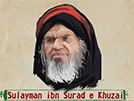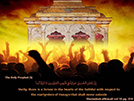Chapter 9-Arabic and Persian Works of ‘Twelver Sunnis’ on the Twelve Imams (‘a)
- Details
- Hits: 2745
Chapter 9
Arabic and Persian Works of ‘Twelver Sunnis’ on the Twelve Imams (‘a) from the 6th to the 10th Centuries
--------------------------------------------------------------------------------
From among the Sunnis, several scholars for various reasons, have written books on the lives of the Twelve Imams (‘a). This is apart from those Sunni scholars who wrote books on the merits of the Ahl al-Bayt (‘a) in general and whose works have been introduced by Sayyid ‘Abd al-‘AzÄ«z TabÄtabÄ’Ä« in his series of articles entitled Ahl al-Bayt fi al-Maktabah al-‘Arabiyyah in the quarterly magazine TurÄthanÄ. The term ‘Twelver ImamÄ« Sunnis’ can be safely used to describe this group of authors. The first book in this regard is the Tadhkirah al-KhawÄss of Yusuf bin FarghalÄ« bin ‘AbdullÄh al-BaghdadÄ« Sibt AbÄ« al-Faraj ‘Abd al-RahmÄn bin al-JawzÄ« (581-654). The author has dwelt on the virtues of the Ahl al-Bayt (‘a) and given an account of the lives and merits of all the Twelve Imams (‘a). Among the books which no longer exist KitÄb al-Al of Ibn KhÄlawayh (d. 370) must have been a similar work as could be gleaned from its passages quoted by IrbilÄ« in his Kashf al-Ghummah.
One of the outstanding figures of this trend among the Sunnis was KamÄl al-DÄ«n Muhammad bin Talhah ShÄfi‘Ä« (d. 652) the author of the renowned book MatÄlib al-Su’ul fÄ« ManÄqib Al-i al-Rasul. IrbilÄ« has praised him for his excellent account of the lives of the Twelve Imams (‘a). ‘Abd al-‘AzÄ«z bin Muhammad known as Ibn Akhzar GunÄbÄdÄ« (d. 611) in his book Ma‘Älim al-‘Itrah al-Nabawiyyah wa Ma‘Ärif Ahl al-Bayt al-FÄtimiyyah al-‘Alawiyyah has written on the lives of only eleven of the Twelve Imams (‘a) and for this reason he has been criticised by ‘AlÄ« bin ‘IsÄ IrbilÄ«.[42]
Two other important examples of Sunni books are al-Fusul al-Muhimmah fÄ« Ma‘rifah AhwÄl al-A’immah by Ibn SabbÄgh MÄlikÄ« (d. 855) and al-ShadharÄt al-Dhahabiyyah fÄ« TarÄjim al-A’immah al-IthnÄ ‘Ashariyyah ‘ind al-ImÄmiyyah by Shams al-DÄ«n Muhammad bin Tulun (d. 953). HamdullÄh MustawfÄ« the author of Nuzhat al-Qulub in his historical account titled TÄrÄ«kh-i GuzÄ«dah, begins with the history of the first three caliphs and then elaborates on the life and virtues of AmÄ«r al-Mu’minÄ«n Imam ‘AlÄ« ibn AbÄ« TÄlib (‘a). In continuation, on page 198 he writes about the life of Imam Hasan (‘a) using the phrase AmÄ«r al- Mu’minÄ«n wa HafÄ«d Rasul Rabb al-‘AlamÄ«n Imam al-MujtabÄ, Hasan bin ‘AlÄ« al-MurtazÄ (‘a) which means “Commander of the Faithful, Grandson of the Messenger of the Lord of the Worlds, the Chosen Imam, Hasan the son of ‘AlÄ« the Pleased.” The thirtieth chapter of the thirtieth section deals with the lives of the other Imams. MustawfÄ« writes: “Concerning the rest of Imams, the pleasure of Allah be upon them all, they were the proof of Allah for mankind. The period of their imamate, starting from 4th of Safar 49 AH till RamazÄn 264, was 215 years and 7 months. The Imams did not rule as caliphs, but since they were deserving (to be caliphs), the benediction of their status travels like perfume on the road of epitome to bring proof.” This discussion continues till the account of the life of the Imam of the Age (‘a).[43]
Another important work is Fasl al-KhitÄb by KhwÄjah Muhammad PÄrsÄ who lived in the ninth century AH. Despite his insistence on being a Sunni and even his strong stances against the Rafidites, he has written about the lives of the Imams (‘a). This part of the book has been published in volume 4 of the series of books titled Islamic Heritage of Iran. The author of RawzÄt al-JinÄn wa JannÄt al JinÄn, DarwÄ«sh Husayn KarbalÄ’Ä« (10th century AH) has also dedicated a lengthy section in his book on the lives of the Imams (‘a). This book has been published.
Among the outstanding works of this nature is the valuable book WasÄ«lah al-KhÄdim ilÄ al-Makhdum dar Sharh SalawÄt ChÄhardah Ma‘sum by FazlullÄh bin RuzbahÄn KhunjÄ« (d. 927) who is famous for his antagonism towards the Shi‘ites and especially the Safawid dynasty. This is an exclusive book on the lives of the Fourteen Infallibles.[44] Kunh al-AkhbÄr is the title of a book on the lives of the Twelve Imams (‘a) and was compiled in the 10th century AH in the Ottoman realm.[45] Even Ibn Hajar HaythamÄ« who wrote al-SawÄ‘iq al-Muhriqah in refutation of what he called the beliefs of the Rafidites, has devoted the whole book to the lives and merits of the Twelve Imams (‘a). One of the most important figures in this regard is MullÄ Husayn KÄshifÄ« who in his book Rawzah al-ShuhadÄ’ has written a brief account of the lives of the Prophets and the Twelve Imams (‘a) as well as issues concerning mourning for them. The most detailed section of this book is dedicated to Imam Husayn (‘a). Another noteworthy book by this particular group of Sunnis is KamÄl al-DÄ«n KhwÄrazmÄ«’s al-Maqsad al-AqsÄ, which in addition to the lives of the caliphs gives an account of the Twelve Imams (‘a).
Notes:
[42] Kashf al-Ghummah, vol. 2, p. 306. It seems that nothing has remained from the book Ma‘Älim, although parts of it have been mentioned by IrbilÄ«; refer to Kashf al-Ghummah, p. 121.
[43] TÄrÄ«kh-e GuzÄ«dah, p. 207.
[44] This book was published with the efforts of the writer of this article (Rasul Ja‘fariyÄn) by the AyatullÄh Mar‘ashÄ« Library, Qum. The new edition of this book, after due research on the basis of a newly discovered manuscript, has been published by AnsÄriyÄn Publishers, Qum.
[45] Refer to the Persian quarterly, Nashr-e DÄnesh, 14th year of publication (1376 SH, month of Esfand (Feb.-March, 1998), p. 58.











